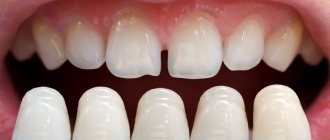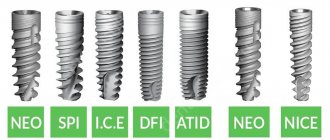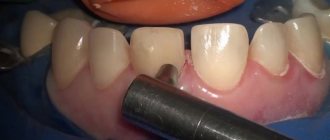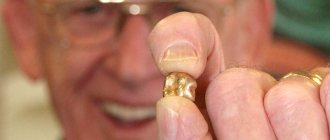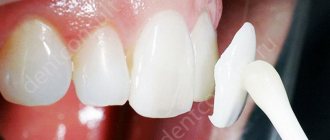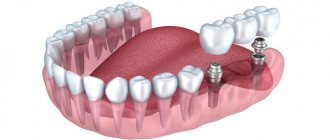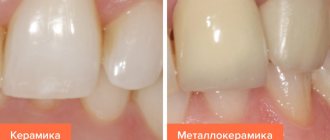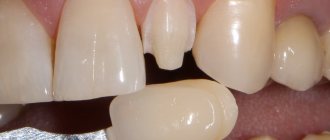Contraindications and restrictions
Since we objectively consider veneers, with their advantages and disadvantages, we note that they have an important practical disadvantage - they are not suitable for everyone.
Doctors do not recommend installing these microprostheses in the following cases:
- There are no premolars (“sixes”), so there are difficulties with chewing function.
- The bite is seriously deformed.
- The incisor is significantly damaged, and therefore it is difficult (there is nothing) to attach the plate.
- The volume of the filling exceeds 50% - this also reduces the reliability of fixation.
- The patient is interested in martial arts, contact sports, or other activities that can cause jaw injuries.
- A person has bad habits that contribute to the appearance of caries or other diseases, for example, bruxism or a passion for cracking nuts.
In any of these situations, you can use some other restoration option. Moreover, such plates must be worn with caution so as not to damage them.
How to remove veneers
Veneers are removed in a medical facility using special devices. It is impossible to remove the linings yourself at home. Even if the plate partially moves away from the enamel due to long-term use, it will not be possible to tear it off completely. Such actions can harm your teeth.
Dental clinics use two main ways to remove veneers:
- Cut it down. Using a diamond bur, the surface of the pad and adhesive particles are removed. It is important that the dentist has experience performing such manipulations. With insufficient qualifications, it will be difficult to recognize where the artificial material ends and the enamel begins.
- Peel off. Using a laser device, the cement that connects the veneer and enamel is evaporated. After this, the plate simply falls off on its own. There are cases when the thickness of the artificial material does not allow the laser beam to reach the interlayer. Then they use a complex method - first they grind the thickness of the plate, and then treat it with a laser beam.
On a note!
All manipulations are performed under local anesthesia. The patient does not feel pain or discomfort.
The benefits of veneers for teeth
Providing a beautiful smile and hiding minor defects, they have the following practical advantages:
- Durability - 5 years is their minimum service life, 7-10 is average (with careful biting of food, oral hygiene and compliance with other rules).
- Environmentally friendly, durable structures designed to minimize the risk of chipping.
- Hypoallergenic - in the manufacture of such pads, materials are used that not only do not cause irritation or other negative reactions, but are also biocompatible with all tissues of the body.
- Aesthetics – when considering the pros and cons of veneers for the front teeth, it is important to consider that they are completely invisible compared to other incisors; It’s not a problem to choose the shade, gloss and even the degree of transparency similar to natural enamel.
- Resistance to staining - the plates do not change their color after drinking tea, wine, coffee and other products, and do not turn yellow as a result of smoking or simply over time; If necessary, they can always be polished.
In addition, microprostheses are distinguished by gentle installation: before fixing them, there is no need to grind the incisor, it is enough to just remove a thin layer of enamel. Well, the edges of these overlays do not have to be hidden in the gums or other soft tissues of the oral cavity. This means no discomfort: with them, a person does not feel a foreign body at all and smiles as naturally as possible. There is also no need to get used to it.
Advantages
The main advantage of veneers is to transform the patient’s appearance as quickly as possible. It allows you to lengthen the tooth, lighten the enamel, and hide the gap between the teeth. In people suffering from bad habits, unsightly dark spots disappear. A snow-white smile is a sign of youth, so many people who have undergone a procedure at the dentist are told that they look at least 10 years younger.
The installation of veneers may also be recommended for medical reasons. For example, it will help cope with increased enamel abrasion. Onlays are also installed to solve minor orthodontic problems. In this case, their benefit significantly outweighs the harm.
Veneer has the following advantages:
- durability: the record will last at least 10 years;
- invisibility: the tooth will look natural and natural;
- absence of plaque: it does not form on the plate;
- hypoallergenic;
- resistance to dyes: stains from coffee, black tea, cigarette smoke, wine do not appear on the surface of the veneer, so they are often used by people with bad habits.
Before installing the plate, a healthy tooth is ground only 0.5-0.75 mm. Of course, this will cause him harm, but only minor. The edge of the veneer is thin, so you don’t have to hide it under the gum, which is a plus. After the procedure, there is no sensation of a foreign body in the mouth, as after prosthetics.
What are the disadvantages of veneers that need to be taken into account?
The main disadvantage is that they cannot be removed by yourself or even dismantled without damaging them. These are not braces. Well, the enamel needs to be prepared - yes, in a thin layer, only 0.5-0.7 mm, but even such an impact can bring negative consequences. Protection against pathogens, aggressive environments, mechanical and chemical factors deteriorates.
As a result, you cannot simply remove the plates - after this you need to either attach new ones or use some other method of restoring the beauty of your smile.
Existing pathologies should also be taken into account. In severe cases, microprostheses can provoke a change in diction. Another disadvantage of veneers lies in the fact that the teeth protruding from under them will still be stained and darken, which means that over time they will become different in color, at least on the inside. To prevent this aesthetic problem, you need to change your menu and stop smoking. Although giving up bad habits is, in principle, a sound idea, even if everything is fine with a smile.
These overlays must be fixed by a specialist, because in case of non-compliance with the technology or errors, the following unpleasant consequences are possible:
- Loose fit and, as a result, darkening of the plate.
- Protruding edges that can cause injury to the soft tissues of the oral cavity.
- A manifestation of hypersensitivity, indicating either poor enamel cleaning or the development of caries.
In addition, you can break off a piece of such a microprosthesis if you thoughtlessly bite into too hard food.
Basic indications for installing plates
Veneers are used for dental problems. If the dental units are fragile, it is worth remembering that the plates will only aggravate the situation. Onlays effectively mask defects and allow you to restore the dentition without causing significant damage to the enamel.
Microprostheses are recommended for chips, cracks, stains on the enamel, uneven teeth, noticeable gaps between them, crowding, developmental defects, age-related changes, worn enamel, injuries, curvatures, wedge-shaped defects, demineralization of the enamel shell after wearing braces.
Only a dentist can tell the patient whether installing veneers will help get rid of existing defects. He will also select the appropriate material for the linings.
Benefits and harms
It is important to understand that the pros and cons of veneers directly affect the quality of your bite. Thus, without much effort, you can visually correct minor imperfections and ensure a whiter and brighter smile. And this is without grinding down the incisor, only with the removal of a thin layer of enamel. If all the rules are followed, the plate will need to be replaced only after 10-20 years - the positive effect is obvious.
On the other hand, abandoning them after the first fixation is already problematic. You have to wear them for the rest of your life, periodically lightening them or putting on new ones. Why? Because 0.5-0.7 of the natural protective coating has already been removed. And the same premolars under microprostheses may ache, because after dental treatment they will become more sensitive and will react more sharply to hot and cold food.
So you should carefully weigh the pros and cons before deciding to have your smile corrected.
Features of the selection of new veneers
When the tooth stumps are freed from the old veneers, they are carefully examined. Firstly, sometimes an examination reveals previously invisible foci of carious lesions under the onlays - of course, they are treated. Secondly, a decision is made: is it necessary to grind them down for new veneers - or was the initial grinding done correctly and is it enough?
Additional grinding may be necessary, for example, if you plan to install porcelain veneers instead of thin lumineers or ceramic instead of composite ones. If a veneer of the same type and from the same material is installed, then usually deeper preparation is not required.
Veneers made from other materials can be placed both according to medical prescriptions and for the patient’s private reasons: for example, previously I wanted to limit myself to lumineers, but I liked the onlays and it was decided to install long-term veneers, or previously financial possibilities only allowed composite veneers, but now there are funds for installation porcelain or ceramics, etc.
The shade of veneers is usually chosen to be the same as it was. But sometimes (again, according to the personal wishes of clients) there are cases when new veneers are placed in a different shade. For example, a person had veneers in his natural shade, but realized that he wanted a brighter smile with lighter veneers. Or, on the contrary, I wanted a natural shade after a period of walking around with a “Barbie smile.”
When the dentist and patient have decided on the material and shade, impressions are taken from the teeth again and sent to a dental laboratory to create veneers based on them. Never, under any circumstances, are “blind” copies of old veneers made - only current, fresh impressions should serve as a guide for dentists!
Cost and service life
Veneering, as an artistic restoration procedure, is always an individual work, painstaking and precise, requiring time and skill, designed for a number of sessions, which affects costs.
Also, prices directly depend on factors such as:
- material and type of records;
- fastening technology;
- number of nozzles;
- associated problems and pathologies.
The average service life is from 5 years (for composite) to 7-8 (for ceramic) or even up to 20 (for zirconium). True, these are not guaranteed figures: the time of comfortable wearing highly depends on attentiveness and accuracy. Some people manage to chip together microprostheses within a week, having decided to chew a pistachio or a “Grilyazh” candy, while others use them happily ever after, following all the rules prescribed by the dentist.
The range in cost allows you to make a choice. You can settle on budget options made from filling materials, get used to them, and then change to better ones. Well, or immediately spend money on a structure made of zirconium and ceramics for the long term. It's up to you to decide, but remember that each new installation means grinding down the enamel and paying for the dentist's labor.
Preparation stages
We carry out diagnostics and dental hygiene
Hygiene and CT scanning are extremely important, without them it is impossible to imagine high-quality installation of veneers today.
Computed tomography
We do this in order to look at all the teeth:
- if we have deep caries,
- where it is necessary to depulpate something,
- where there is inflammation,
- Are all the channels sealed correctly?
- how close is caries to the nerve,
- as a condition of the maxillary sinuses,
We also do a CT scan of the head in order to model everything in 3D.
Dental hygiene
is needed in order to work not with plaque, but with clean teeth.
Hygiene is also done in order to correctly determine the color. Because, for example, if we chose a color before professional hygiene, and then the patient brushes his teeth and it turns out that the color that we previously chose for veneers will stand out from the general range. After all, patients do not always place 20 veneers at once; we can talk about single dental restorations.
We remove damage to the enamel and dental tissues
I carried out the grinding for the mockup using special marking burs, so we cut off exactly as much as was needed to make a beautiful male smile
:
The grinding of some teeth affected by caries looks quite serious in the photo:
In all the examples in the photo below you can see a strong lesion
hard tissues of teeth.
In simple words, part of the teeth: the front incisors, premolars - rotted, that is, the caries was on the coronal part (crowns) of the teeth and was very deep. You can also see defects formed on the crowns, in those places where caries has severely affected the tooth. Pay attention to caries of the anterior incisors
:
This is what caries looks like on a canine
:
A rather positive factor was that the roots of the teeth remained intact. And if the tooth root is intact, it can be completely restored without removal or implantation.
Getting ready to change the shape of your teeth
We also had to play a little with the shape of the teeth in order to close all the gaps
when there are so many cracks and to do everything without cracks - it must be simply amazing professionalism.
We had to “play” not so much with the height, since our height hasn’t changed much, but rather with the width of the teeth
. Due to damage to the tooth enamel, carious teeth are literally rotten through and through. Each tooth had two caries on each side, and it also spread to the gingival areas.
In fact, the turning turned out very good and beautiful, clean. Absolutely free of dental caries. After installing veneers, Vitaly will not have caries for many years. This grinding allowed us to prepare the teeth and create a completely straight smile.
3D visualization
Why have I been using 3D visualization in my work for a long time? Because 3D visualization is the only way to show very clearly (both to me, to the patient, and to the technician) all the guidelines for the placement of teeth and the future smile.
Virtual 3D setup
- this is, first of all, absolute clarity for the patient, confirmation of the correctness of his decision about a beautiful smile:
A model was created on the computer - a virtual smile design. Then they 3D printed models of his future temporary teeth. That is, first we create two models on our computer - the first thing we do is wax up to make temporary veneers. The second step is to create a second veneer design on the prepared teeth. As a rule, both designs are the same, although it is believed that the second 3D veneer design is a more advanced 3D wax up
.
Installation of lumineers
Lumineers are translucent ceramic overlays, no more than 0.3 mm thick, which makes them almost invisible on the teeth. They are installed if the patient has beautiful and healthy teeth, but wants to improve his smile. Lumineers (also known as non-prep veneers) do not require extensive grinding of the tooth, allowing the majority of the enamel to be preserved. You can read more about Lumineers in this article.
